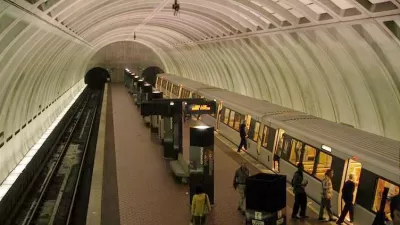For the first time since the system was opened in 1976, Washington D.C.'s iconic subway stations are getting a substantial redesign. Preservationists and historians are questioning the appropriateness of the changes.
The dark and cold design language deployed across the system by principal architect Harry Weese is due to get a 21st century update in a plan announced this week by Washington's transit agency. "Stainless steel, bright lights and clear glass would supplant the soft lighting and dark colors that were defining elements of the subway system when it was designed and built in the 1960s and 1970s," reports Dana Hedgpeth.
"The proposed changes, which would be most noticeable in some of the system’s underground stations, mark a striking departure for Metro. And just as the system’s original design was the subject of great debate, the transit agency’s announcement is already eliciting pointed critiques from some quarters."
"The announcement is sure to stir some of the transit agency’s critics, who are likely to say the rail system’s performance, not its aesthetics, should be the focus. But historic preservationists and transit historians have their own critiques, saying the new design will compromise the distinctive design that emerged from years of debate over what a subway system for the nation’s capital should look like."
FULL STORY: Metrorail plans to renovate stations

Maui's Vacation Rental Debate Turns Ugly
Verbal attacks, misinformation campaigns and fistfights plague a high-stakes debate to convert thousands of vacation rentals into long-term housing.

Planetizen Federal Action Tracker
A weekly monitor of how Trump’s orders and actions are impacting planners and planning in America.

San Francisco Suspends Traffic Calming Amidst Record Deaths
Citing “a challenging fiscal landscape,” the city will cease the program on the heels of 42 traffic deaths, including 24 pedestrians.

Cleveland to Boost Bike Safety With New Bike Lanes, School Programs
The program, using curriculum created by Cleveland Bikes, is part of a broader effort to improve safety along school routes.

Florida Home Insurers Disproportionately Dropping Low-Income Households
Non-renewal rates are highest in inland counties, not the coastal areas most immediately vulnerable to storms.

Half of Post-Fire Altadena Home Sales Were to Corporations
Large investors are quietly buying up dozens of properties in Altadena, California, where a devastating wildfire destroyed more than 6,000 homes in January.
Urban Design for Planners 1: Software Tools
This six-course series explores essential urban design concepts using open source software and equips planners with the tools they need to participate fully in the urban design process.
Planning for Universal Design
Learn the tools for implementing Universal Design in planning regulations.
Gallatin County Department of Planning & Community Development
Heyer Gruel & Associates PA
JM Goldson LLC
City of Camden Redevelopment Agency
City of Astoria
Transportation Research & Education Center (TREC) at Portland State University
Jefferson Parish Government
Camden Redevelopment Agency
City of Claremont



























